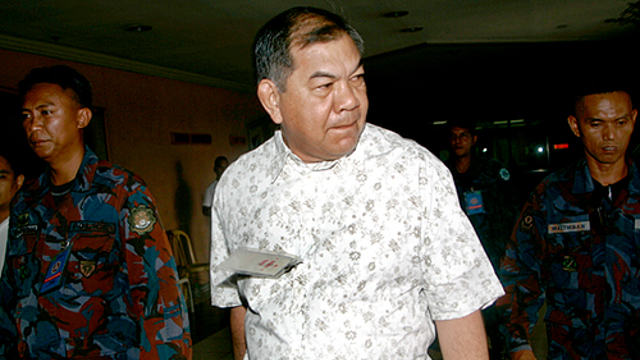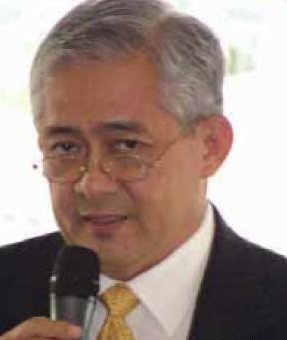SUMMARY
This is AI generated summarization, which may have errors. For context, always refer to the full article.

MANILA, Philippines – The Sandiganbayan, an anti-graft court, is supposed to punish the corrupt. But in the case of ex-military comptroller Carlos Garcia, the Sandiganbayan justices issued a “corrupt order” to favor him, the Office of the Solicitor General (OSG) said.
“Something anomalous” probably happened from the time the plunder case – which is non-bailable – was filed against Garcia in 2004 to the period when the Sandiganbayan approved a plea bargain that dropped the case against him, the OSG told the Supreme Court in a petition.
READ: Briefer on the plunder case against Garcia
The 110-page OSG petition was the basis of a temporary restraining order that the high court issued on Wednesday, July 3, stopping the Sandiganbayan from implementing the deal.
In April 2013, the anti-graft court sustained the plea bargain agreement entered into by Garcia and the former Ombudsman that allowed him to escape a possible perpetual imprisonment. The plea allowed him to plead guilty to lesser offenses of indirect bribery and facilitating money laundering, all bailable.
READ: How the big fish got away
Under this deal, Garcia would return properties, stocks, and bank deposits totaling P135 million that he supposedly amassed while he was military comptroller – barely half the P303-M that he supposedly illegally acquired as stated in the plunder charges against him.
Garcia’s case has been the biggest scandal to hit the armed forces in recent history, prompting a massive revamp. His controversial plea forced then Ombudsman Merceditas Gutierrez in early 2011 to quit before she could face an impeachment trial.

READ: Court approves Garcia bargain deal
The OSG noted that only 3 months after the anti-graft court ruled there was sufficient evidence to warrant the denial of Garcia’s petition for bail, the Office of the Special Prosecutor (OSP), which is under the Ombudsman, somersaulted and agreed with Garcia that the evidence against him was weak.
Without discussing the merits of the evidence, the Sandiganbayan agreed with OSP and Garcia’s argument, effectively reversing its initially findings.
“This is certainly absurd and bespeaks something anomalous happened,” the OSG said.
The OSG said the Sandiganbayan, through Martires, tried to justify its April 20, 2013, final decision on the Garcia case by saying it had actually realized the weakness of the case as early as May 2010. (The April 20 resolution denied with finality the OSG’s motion to intervene and reconsider the plea bargain.)
The anti-graft court then explained that it decided not to put in writing its findings about the prosecution’s weak evidence, supposedly to avoid giving Garcia prior information that might make him backtrack from the plea agreement.
‘A lot of bull’
The OSG scoffed at this claim, accusing the Sandiganbayan justices of “self-serving afterthought.”
The justices’ move to “to paint their actions as ‘heroic,’ are shameless excuses to justify a clearly corrupt order. To be sure, the Sandiganbayan honestly believes it can hoodwink the SC, not to mention the people, into believing a story that, to any unbiased mind, is simply a lot of bull.”
Aside from Martires, the justices who ruled in Garcia’s favor were Associate Justices Teresita V. Diaz-Baldos, Roland B. Jurado, and Alex L. Quiroz. The lone dissenter was Associate Justice Oscar Herrera Jr, an appointee of President Benigno Aquino III.
Assuming that the plunder case was weak, Garcia could still be prosecuted for lesser crimes, such as bribery and money laundering, which had not entered the pre-trial stage, according to the OSG. His ill-gotten wealth could still be recovered considering the forfeiture cases filed against Garcia, it added.
The Sandiganbayan also allowed the inclusion of money laundering as part of the plea bargain, when proceedings in this separate case had yet to start, the OSG headed by Solicitor General Francis Jardeleza said.
“Worse, the plea of guilt to the lesser charge of facilitating money laundering was not made…against [the] principal accused. Instead, the same was directly effected in favor of the…accused, together with the dismissal of the main charge against all the other accused.”
The plea bargain, after all, allowed Garcia’s wife Clarita and their children – who are his co-accused – off the hook.
The OSG said the Sandiganbayan accepted hook, line, and sinker Clarita Garcia’s statement that their unexplained wealth came from other income-generating sources. Clarita said the family income came from two other family-owned firms as well from “gratitude and goodwill money” given to her husband.
In taking Clarita’s assertion as gospel truth, “the respondent Court practically serve as advocate on behalf of the interests of the accused,” the OSG said. “The allegations by Clarita regarding the alleged sources of income are simply bare assertions…. The Court cannot equate such bare assertions with the admissions regarding the gratitude money,” the OSG said.
This is not the first time that the Sandiganbayan ruling on the Garcia deal was questioned.
Lone dissenter
Herrera, the lone Sandiganbayan justice who dissented in the decision, raised an alleged irregularity in the way his colleagues reached the verdict.
Sources close to the court earlier told Rappler that Herrera confronted his fellow justices about how the 5 justices of the special division that tackled the plea bargain deal were chosen. He said two of them – Jurado and Quiroz – were handpicked by then Presiding Justice Francisco Villaruz.
On this basis, sources told Rappler, Herrera was considering filing a complaint against his fellow justices before the Supreme Court. As of posting, he has not filed any.
The Sandiganbayan’s head Villaruz has since retired. the Judicial Bar Council is now in the process of interviewing nominees to replace him.
In his dissent, Herrera argued that since the government, through the OSG, was questioning the deal, it should already be nullified. It was the government, after all, through the Ombudsman, that signed the deal with Garcia in the first place, he added.
Garcia’s case exposed systemic and wanton corruption in the Philippine military and a cabal of officers that perpetuates financial anomalies. As as a result, the military high command collapsed the comptroller department.
Read the entire OSG petition here:
– Rappler.com
Add a comment
How does this make you feel?
There are no comments yet. Add your comment to start the conversation.